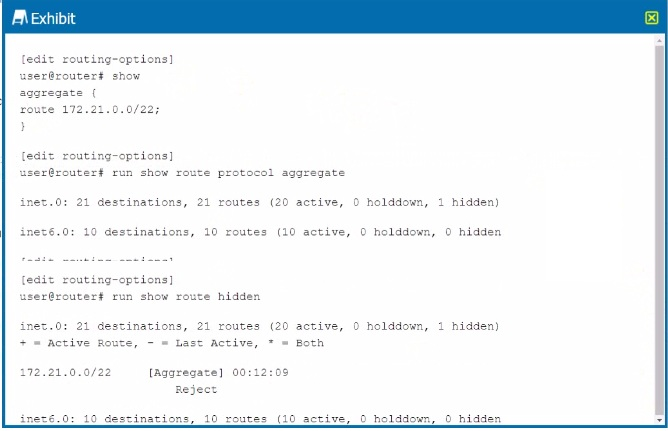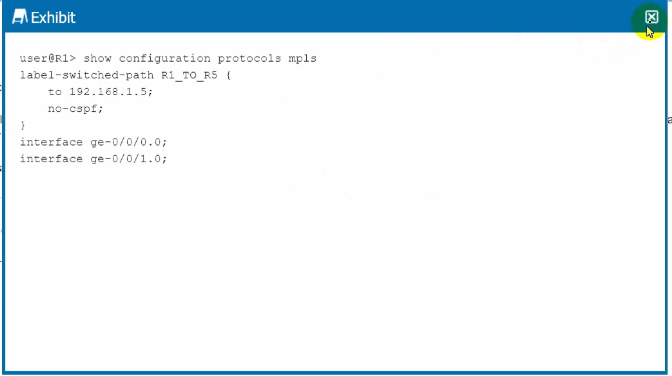Most Recent Juniper JN0-363 Exam Dumps
Prepare for the Juniper Service Provider Routing and Switching, Specialist exam with our extensive collection of questions and answers. These practice Q&A are updated according to the latest syllabus, providing you with the tools needed to review and test your knowledge.
QA4Exam focus on the latest syllabus and exam objectives, our practice Q&A are designed to help you identify key topics and solidify your understanding. By focusing on the core curriculum, These Questions & Answers helps you cover all the essential topics, ensuring you're well-prepared for every section of the exam. Each question comes with a detailed explanation, offering valuable insights and helping you to learn from your mistakes. Whether you're looking to assess your progress or dive deeper into complex topics, our updated Q&A will provide the support you need to confidently approach the Juniper JN0-363 exam and achieve success.
The questions for JN0-363 were last updated on May 5, 2025.
- Viewing page 1 out of 17 pages.
- Viewing questions 1-5 out of 86 questions
Exhibit

Referring to the exhibit, what is the minimum number of LSPs required to support alt four networks?
Given the RSVP Signaled Service Provider MPLS Core network shown in the exhibit, only a single Label Switched Path (LSP) is required to support all four networks because MPLS can use label stacking to multiplex multiple LSPs over a single physical path. Therefore, one LSP can be established through the MPLS core, and all networks can use this LSP with different label stacks. Reference::
MPLS Fundamentals, Juniper Networks Documentation
RSVP-TE Signaling, Juniper Networks Documentation
Which two statements are correct about IS-IS interface metrics? (Choose two.)
metric---Metric value. Range: 1 through 63, or 1 through 16,777,215 (if you have configured wide metrics) Default: 10 (for all interfaces except lo0), 0 (for the lo0 interface)
Exhibit.

Referring to the exhibit, you have configured an aggregate route that represents the 172.21.0.0/24, 172.21.1.0/24, and 172.21.2.0/24 networks. However, when you view the routing table, your new route hidden.
Which action would you perform to determine the problem?
The exhibit shows an aggregate route configuration for the network 172.21.0.0/22, which would summarize the specific networks 172.21.0.0/24, 172.21.1.0/24, and 172.21.2.0/24. For an aggregate route to be active, it must have contributing routes in the routing table. If the route is hidden, it usually means there are no contributing routes that are active or the policy applied to the aggregate does not match any of the specific routes. Therefore, the first step in troubleshooting would be to verify that there are indeed active contributing routes for the aggregate to be valid.
Juniper documentation on routing policies and aggregates: Junos OS Routing Policies, Firewall Filters, and Traffic Policers User Guide
Which two statements ate correct about the BGP next-hop attribute value? (Choose two.)
By default, the router that originally sourced the route into BGP places its peer address into the attribute field. The next-hop value is then typically changed when the route is transmitted across external gGP (EBGP) links. Internal BGP (IBGP) peers do not alter the next-hop value between themselves.
B. By default, the next-hop value is changed when a route is passed from an EBGP peer to another EBGP peer. C. By default, the next-hop value is retained when a route is advertised across IBGP links. Reference::
BGP Next Hop Attribute, Juniper TechLibrary
Understanding BGP Next-Hop Selection, Juniper TechLibrary
Exhibit

You have an established LSP between your R1 and R5 devices using the configuration shown in the exhibit. You are asked to ensure that MPLS labels are used to forward traffic by all devices within the LSP.
Which action will accomplish this behavior?
The 'ultimate-hop-popping' term refers to the action taken by the penultimate router in an LSP to remove the MPLS label before delivering the packet to the ultimate router, which is not desired here. Configuring the 'explicit-null' statement causes the penultimate router to replace the top label with a label that has a value of 0, which instructs the ultimate router to perform a label lookup and preserve the label switching for the entire LSP.
Juniper Networks documentation on MPLS: MPLS Applications User Guide for Routing Devices
Unlock All Questions for Juniper JN0-363 Exam
Full Exam Access, Actual Exam Questions, Validated Answers, Anytime Anywhere, No Download Limits, No Practice Limits
Get All 86 Questions & Answers